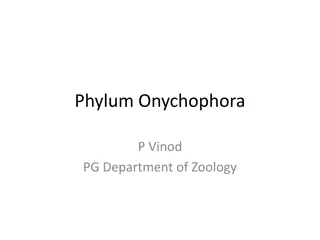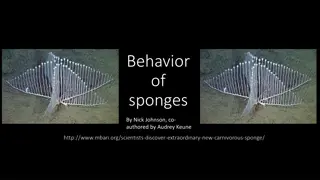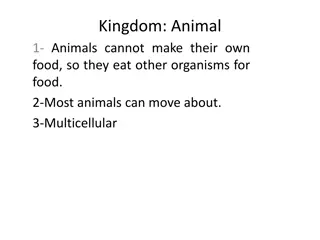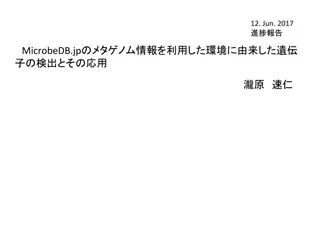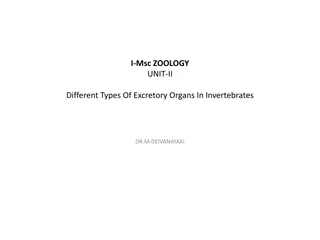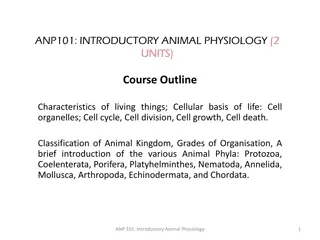Understanding Body Plans of Animals in the Animal Kingdom
Introduction to the diverse phyla within the Animal Kingdom, highlighting key features of body plans such as symmetry, cephalization, tissue layers, coeloms, and gut types. Exploring the classification system through common characteristics shared within phyla and the significance of morphology in gr
1 views • 54 slides
Phylogenetic Status of Peripatus: Exploring its Systematic Position
Peripatus, known as claw bearers, exhibits characteristics of both annelids and arthropods, making it an intriguing species in the study of evolutionary biology. Considered as an intermediate link between these two phyla, Peripatus raises questions about its classification and evolutionary history.
0 views • 10 slides
Insights into Evolutionary Adaptation and Genetic Variation
The production order highlights the essential role of genomic variation as fuel for natural selection, driving evolutionary adaptation. The Cambrian Explosion timeframe reveals a rapid increase in evolutionary adaptation, showcasing the appearance of diverse animal phyla over a relatively short peri
5 views • 6 slides
Insights into the Behavior and Life Cycle of Sponges
Sponges exhibit unique behavior characteristics both externally and internally. They are sedentary organisms with cylindrical bodies that can be soft or hard, flexible or brittle. Sponges reproduce via sexual and asexual methods, and go through a life cycle from larvae to adulthood. Their reproducti
0 views • 6 slides
Exploring Diversity in Porifera and Cnidaria Phyla Through Lab Observations
You were exposed to the wide array of animals in the Porifera and Cnidaria phyla in a lab exercise. Understanding the distinguishing features of each group, their roles in the environment, and the structures crucial for identification is key. Focus on bold-faced structures and labeling on diagrams a
0 views • 12 slides
Understanding Protozoa: The Animal-Like Unicellular Organisms
Protozoa are unicellular heterotrophic organisms that obtain nutrition by ingesting other organisms or dead organic material. They can be parasitic and are classified based on their modes of locomotion. Common groups include amoebas, flagellates, sporozoans, and ciliates. Protozoa are further catego
0 views • 16 slides
Understanding the Classification of Living Organisms
Living organisms are classified into five kingdoms, each further divided into smaller groups called phyla, classes, orders, and genus. The five kingdoms are Monera, Fungi, Protista, Plantae, and Animalia. Animals are categorized into invertebrates and vertebrates, with significant agricultural impor
0 views • 50 slides
Overview of Animal Kingdom's Phyla and Characteristics
Animals in the Kingdom Animalia have diverse characteristics and are classified into different phyla based on specific traits and features. This includes Porifera (sponges), Cnidaria (jellyfishes), Platyhelminthes (flatworms), Nematoda (roundworms), Annelida (earthworms), Mollusca (snails, octopus),
0 views • 10 slides
Exploring Mollusks and Echinoderms
Delve into the fascinating world of Mollusks and Echinoderms through this informative review. Learn about their unique characteristics such as radula, tube feet, gills, and bilateral symmetry. Discover the importance of these features in the diverse phyla of Mollusca and Echinodermata, including the
0 views • 25 slides
MicrobeDB Database Analysis for Microbial Diversity
In June 2017, data from MicrobeDB.jp was analyzed, revealing microbial diversity in various phyla and families. The study included Wilcoxon P-values and abundances of different microbial genera. The analysis indicated the presence of various bacterial and archaeal species in different environments,
0 views • 20 slides
Overview of Different Excretory Organs in Invertebrates
In invertebrates, there are various types of excretory organs such as the contractile vacuole, nephridium, renal gland, coxal gland, and Malpighian tubule. These organs play crucial roles in osmotic regulation and nitrogen excretion. Different phyla exhibit diverse excretory structures like nephridi
0 views • 6 slides
Introduction to Animal Physiology and Cellular Biology Overview
This comprehensive course delves into the fundamental aspects of animal physiology and cellular biology. Topics covered include the characteristics of living organisms, cellular organelles, the cell cycle, division, growth, and death. Additionally, the course introduces the various animal phyla, fro
0 views • 43 slides
Exploring the Fascinating World of Algae: A Visual Journey Through Different Phyla
Dive into the diverse and intriguing realm of algae with this visual guide. From the catchall kingdom Protista to the distinct phyla Chlorophyta, Phaeophyta, Rhodophyta, Bacillariophyta, Dinoflagellata, and more, learn about their characteristics, structures, and importance. Discover how green algae
0 views • 32 slides

